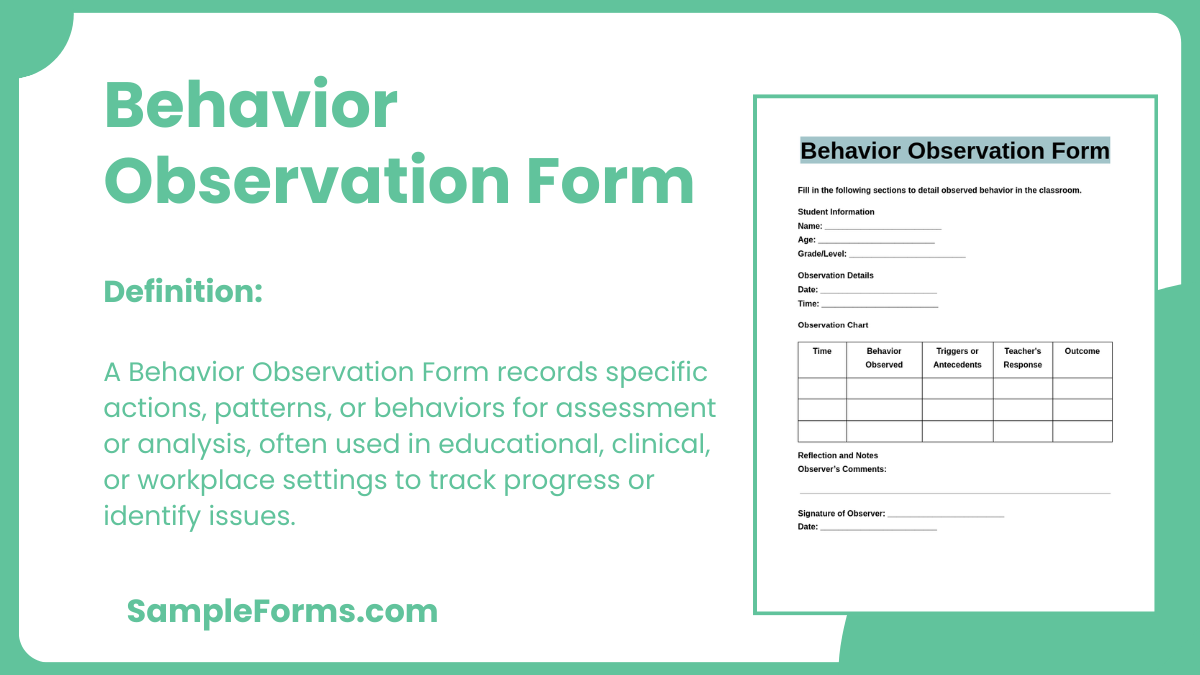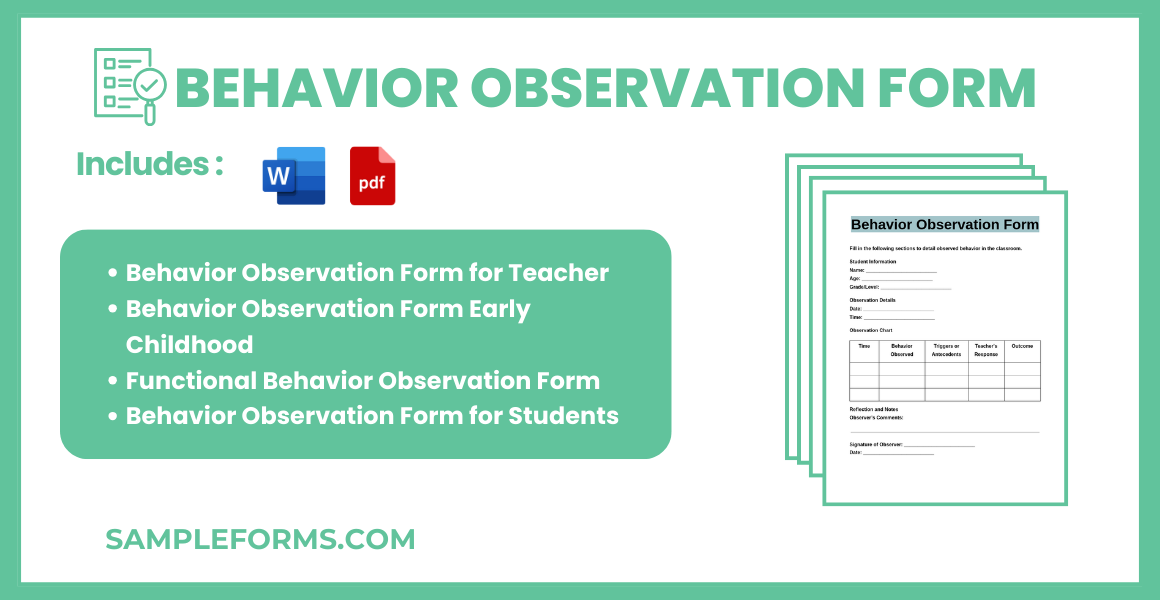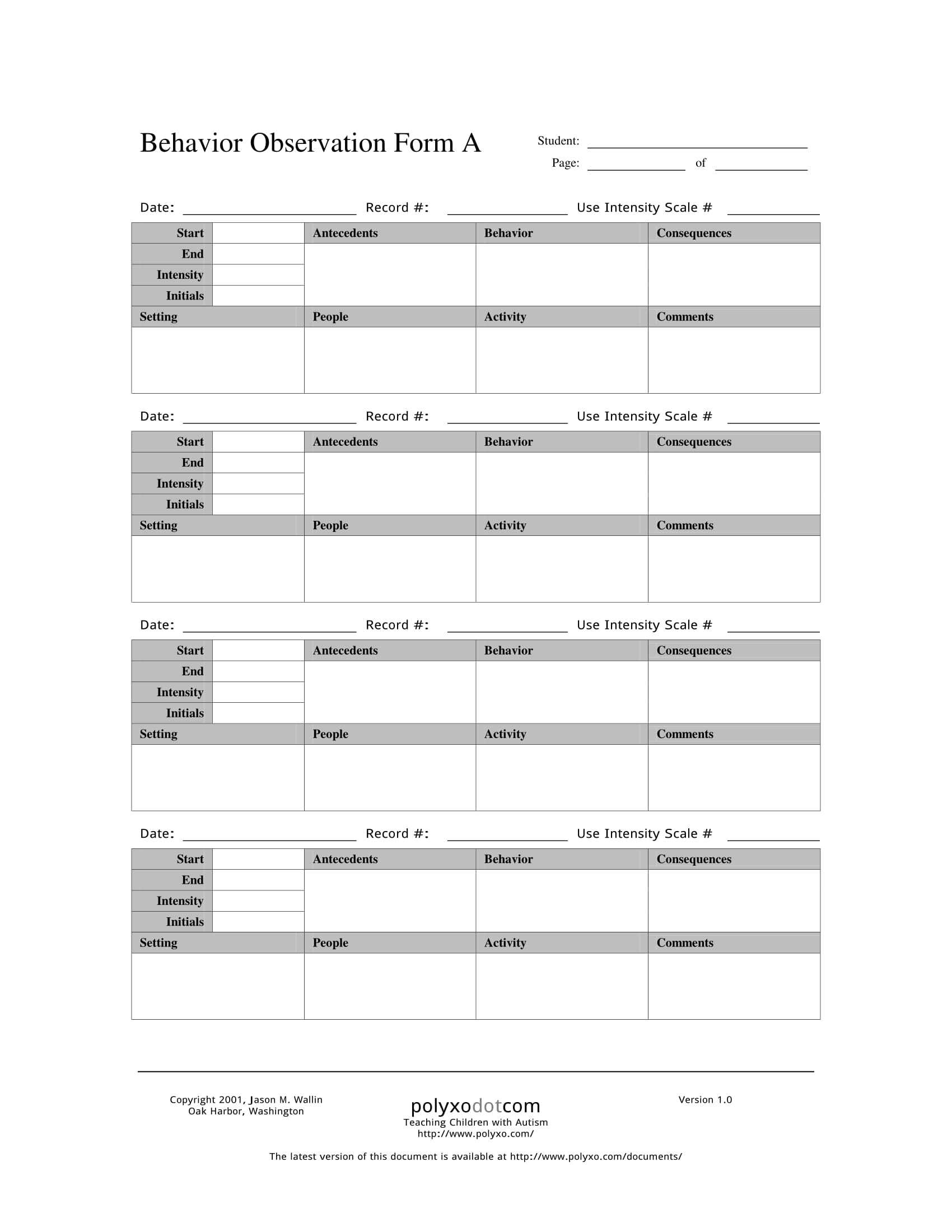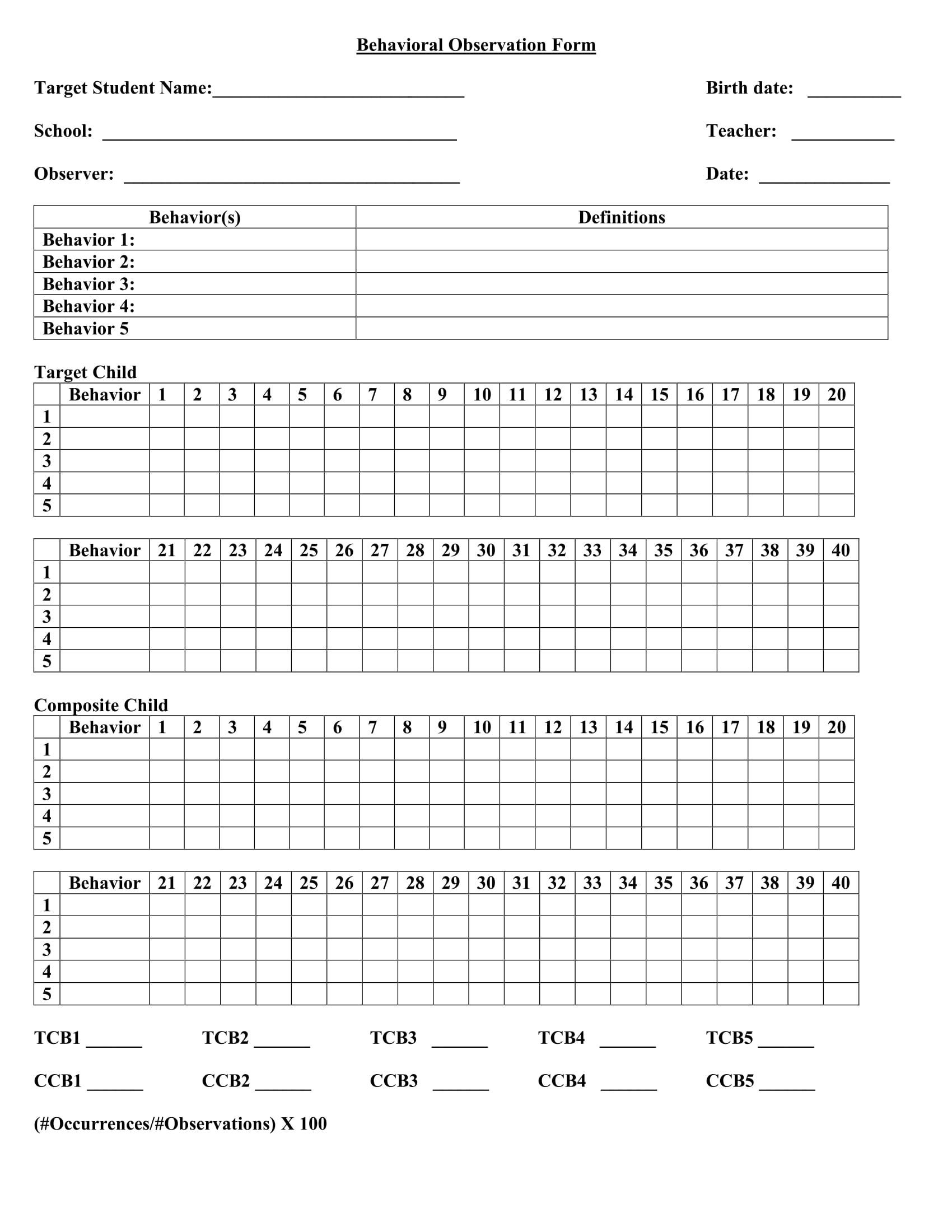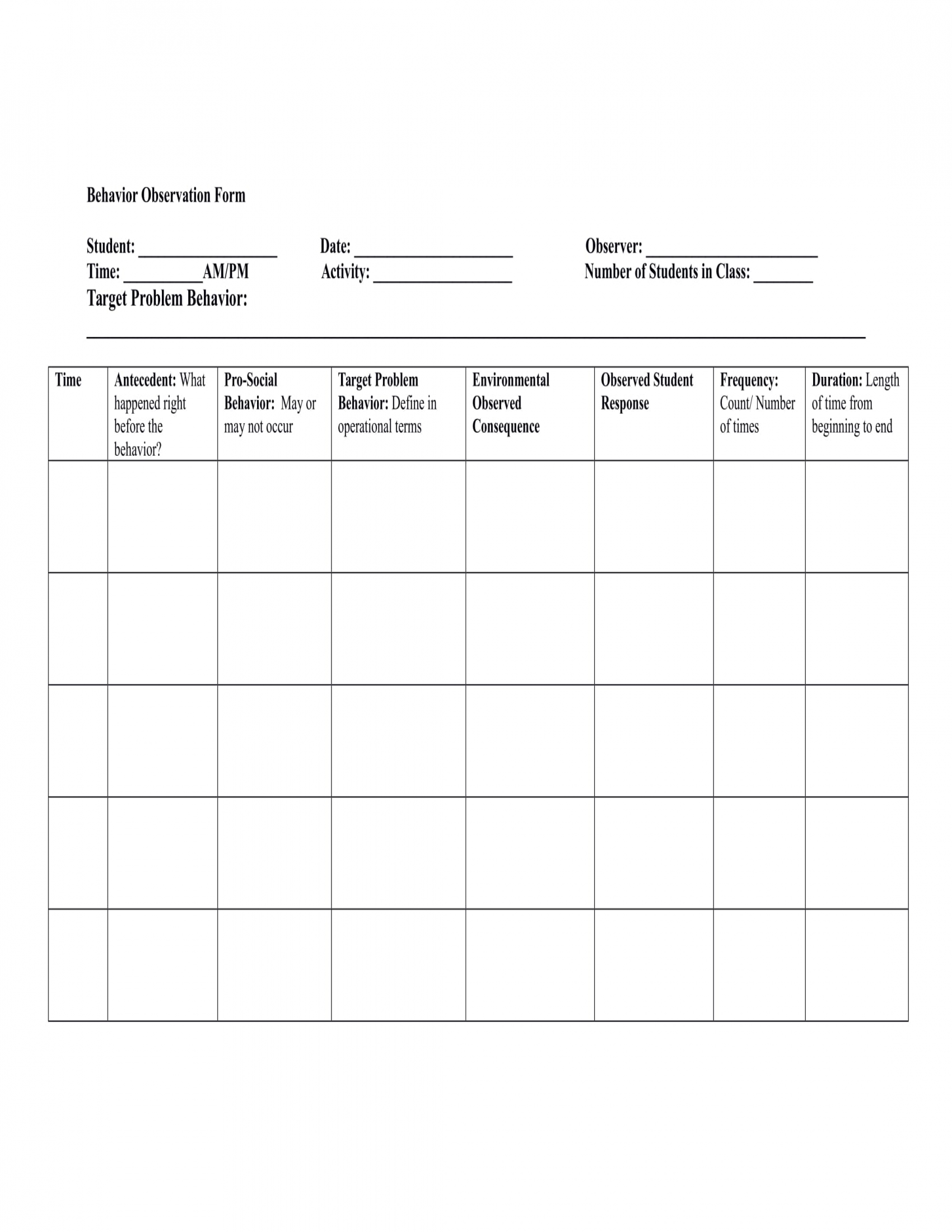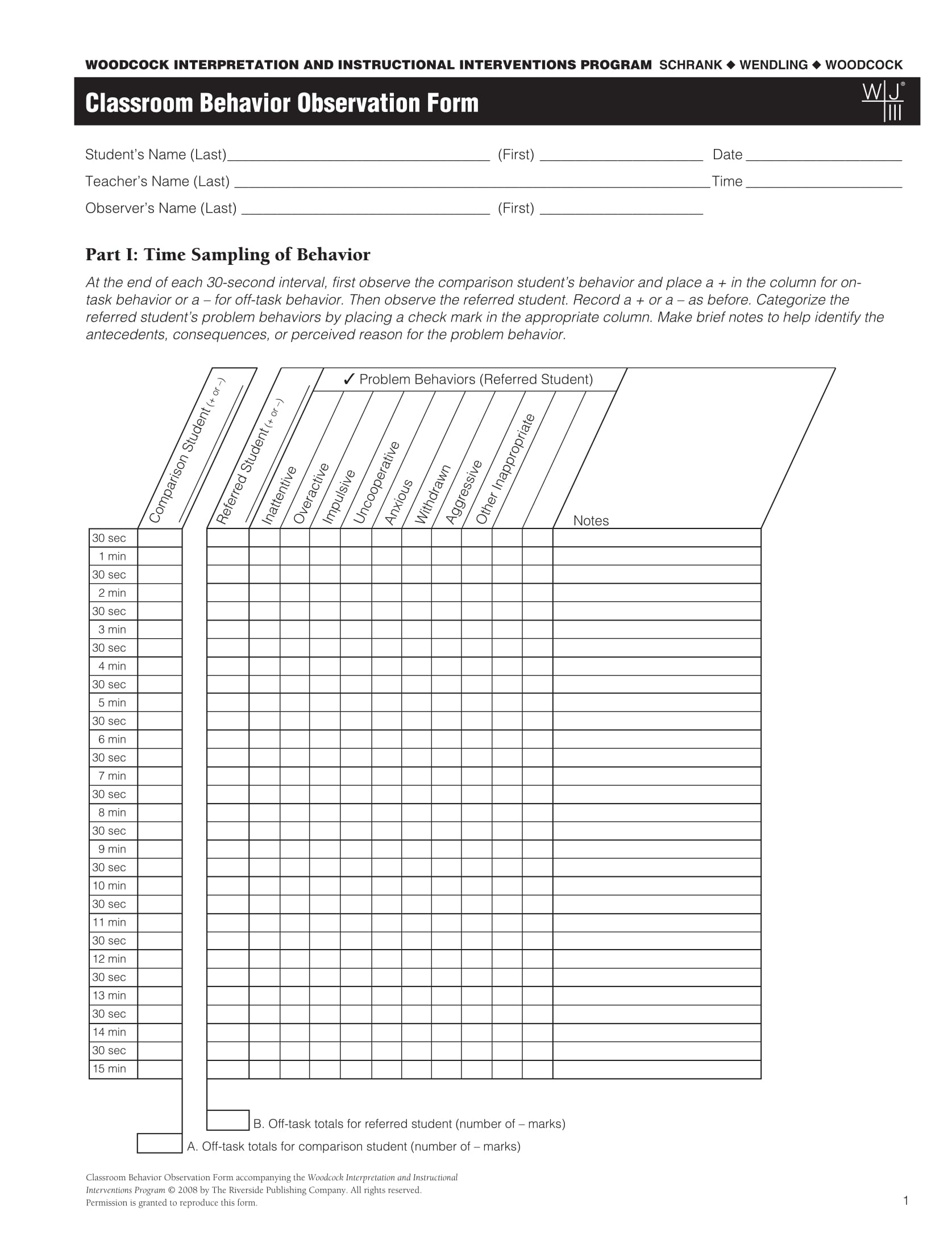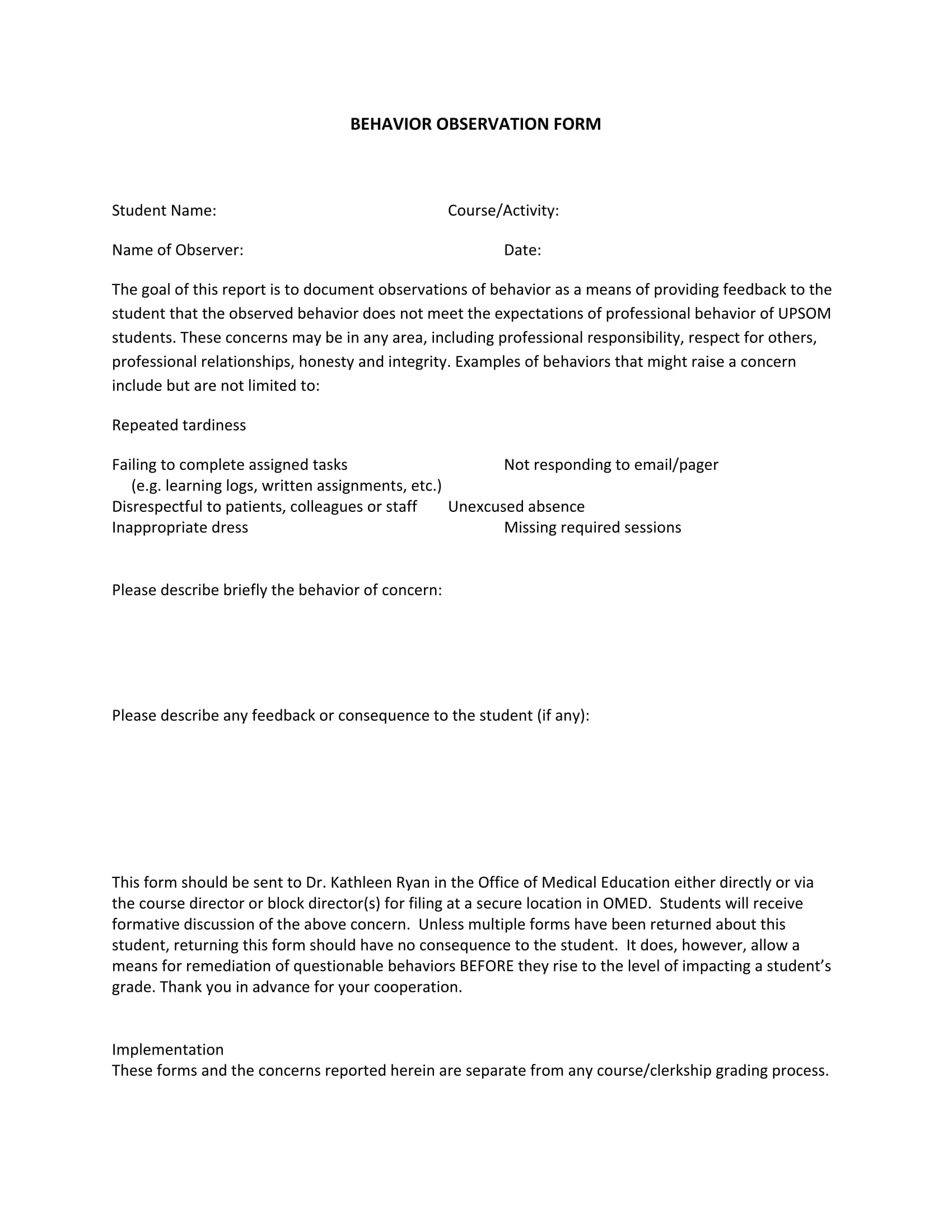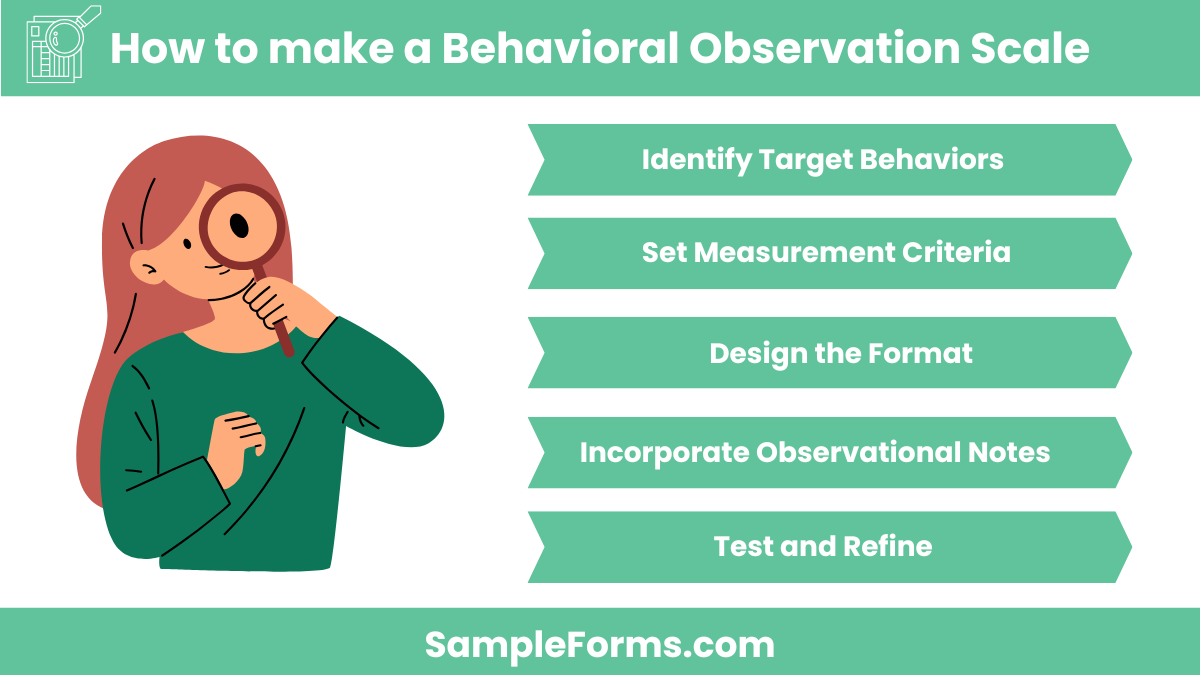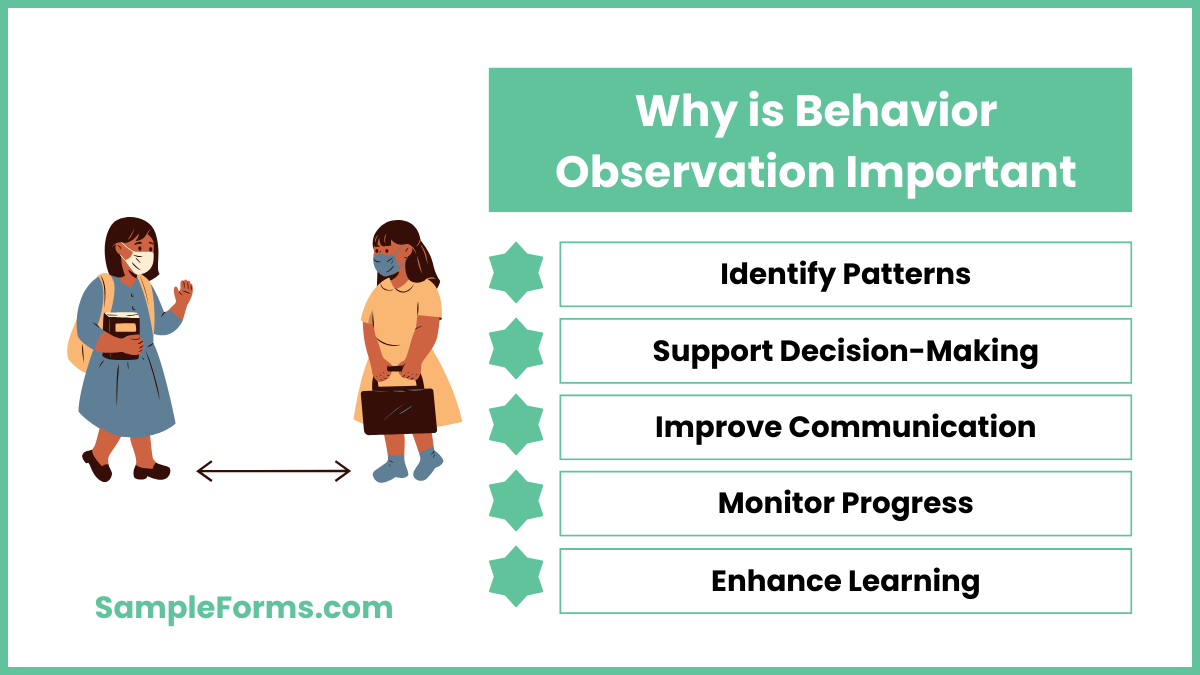A Behavior Observation Form is an essential tool for tracking, analyzing, and documenting behaviors. This guide explores practical examples to improve understanding. From creating a Behavior Contract to using a Peer Observation Form, discover its structure, benefits, and how it aids educators, employers, and parents. Designed to enhance communication, foster growth, and identify patterns, this form is vital in behavioral analysis. Whether managing classrooms, workspaces, or specialized settings, mastering its use ensures meaningful and effective outcomes. Learn the steps to make this process seamless, promoting better decisions and results for individuals and organizations.
Download Behavior Observation Form Bundle
What is Behavior Observation Form?
A Behavior Observation Form is a document used to monitor, record, and evaluate behaviors systematically. It captures specific actions, contexts, and triggers, aiding in understanding patterns. Widely utilized in educational, workplace, and therapeutic settings, it ensures effective communication and targeted interventions. By providing detailed insights, it empowers teachers, employers, and caregivers to make informed decisions. This form promotes accountability, improvement, and collaboration by documenting real-time behavior.
Behavior Observation Format
Observer Details
Full Name: __________________________
Role/Position: __________________________
Date of Observation: __________________________
Time of Observation: __________________________
Subject Information
Name of Subject: __________________________
Age: __________________________
Grade/Class/Role: __________________________
Observation Context (Location, Activity, etc.): __________________________
Behavior Description
Detailed Description of Observed Behavior: __________________________
Behavior Frequency (Occasional, Frequent, Constant): __________________________
Duration of Each Episode: __________________________
Intensity Level of Behavior: __________________________
Triggers and Consequences
Environmental Triggers or Antecedents: __________________________
Subject’s Response to Triggers: __________________________
Consequences Observed After Behavior: __________________________
Patterns Identified: __________________________
Recommendations
Immediate Steps for Intervention: __________________________
Long-Term Strategies for Support: __________________________
Additional Resources Required: __________________________
Any Follow-Up Observations Needed: __________________________
Acknowledgment
Observer’s Name: __________________________
Observer’s Signature: __________________________
Date: __________________________
Behavior Observation Form for Teacher
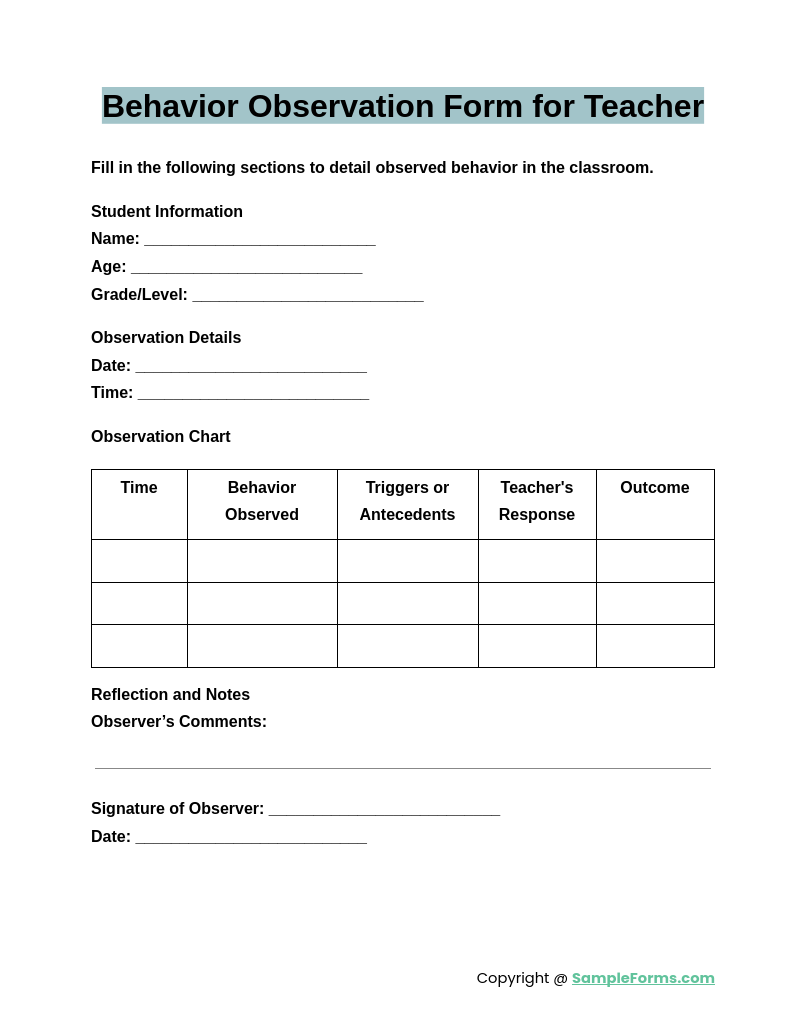
A Behavior Observation Form for Teacher helps educators systematically monitor and assess student behavior in classrooms. Using a Functional Behavior Assessment Form, teachers can identify patterns, address issues, and implement strategies for positive behavioral outcomes effectively.
Behavior Observation Form Early Childhood
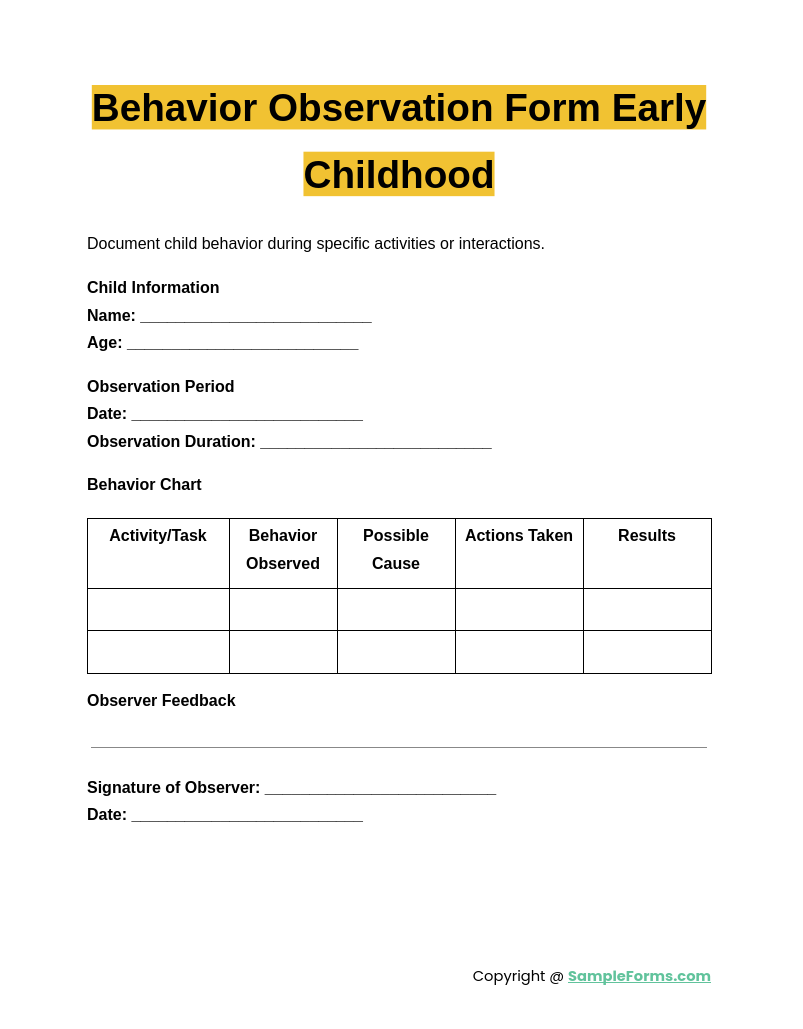
A Behavior Observation Form Early Childhood is crucial for documenting young children’s actions during early development stages. This tool often integrates a Behavior Tracking Form to help caregivers and educators spot patterns and intervene when necessary.
Functional Behavior Observation Form
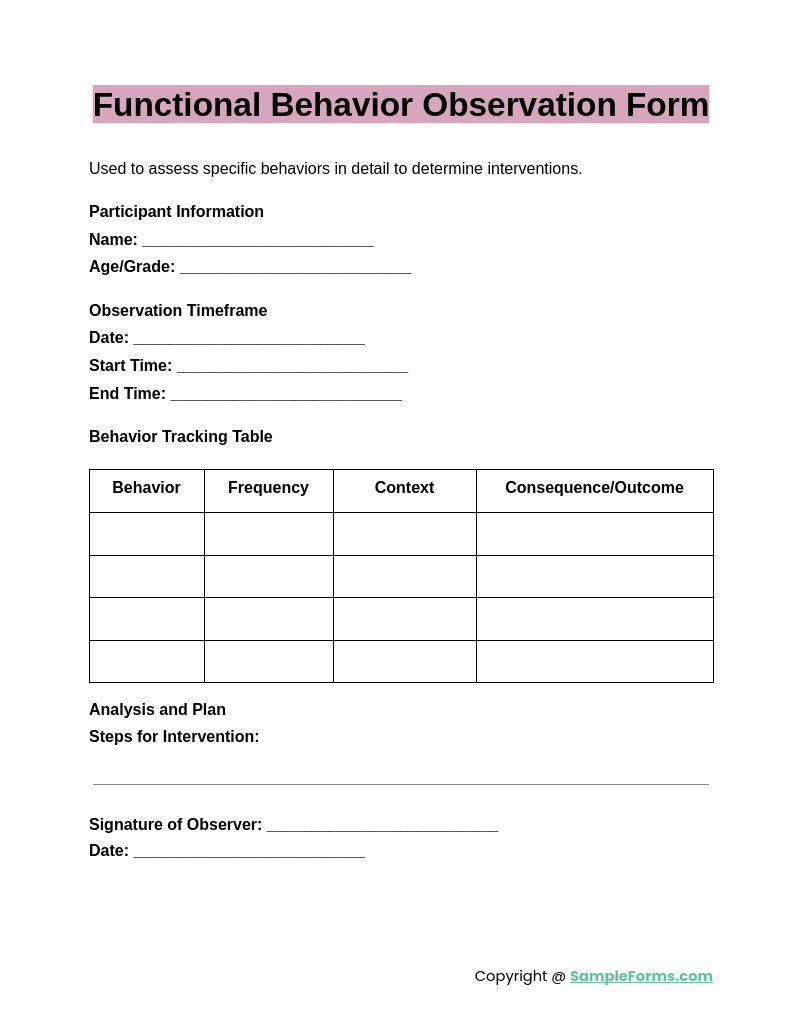
A Functional Behavior Observation Form is essential for identifying triggers and functions of specific behaviors. Combining insights from a Student Behavior Contract, it aids in formulating actionable plans to guide behavioral improvements and foster accountability.
Behavior Observation Form for Students
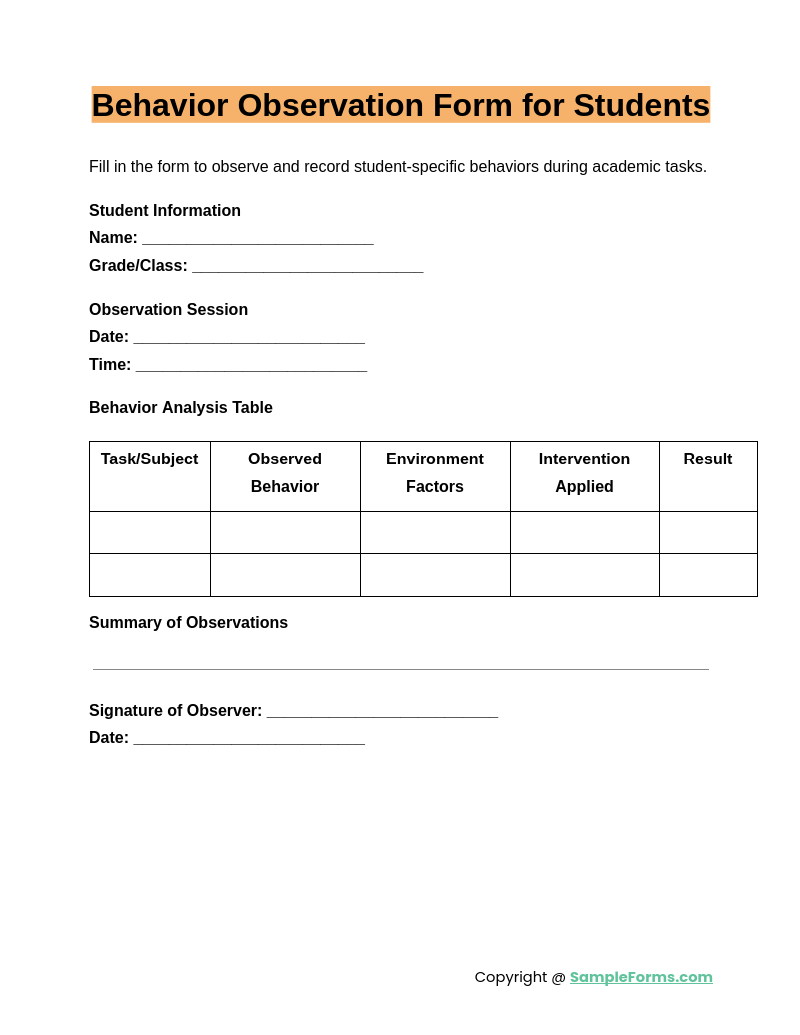
A Behavior Observation Form for Students is designed to document and evaluate student actions systematically. Incorporating elements like a Behavior Report Form, it supports teachers and counselors in creating tailored strategies for managing and improving behaviors effectively.
Browse More Behavior Observation Forms
Behavior Observation Form Sample
Behavioral Observation Form Template
Behavior Observation Form in DOC
Classroom Behavior Observation Form
Student Behavior Observation Form
How do you make a behavioral observation scale?
Creating a behavioral observation scale requires careful identification of specific behaviors to monitor and measure. It’s often used alongside a Behavior Contract Form to ensure clarity and consistency.
- Identify Target Behaviors: Define specific behaviors to observe, ensuring they align with the goals of the observation.
- Set Measurement Criteria: Develop clear rating scales or categories for evaluating each behavior.
- Design the Format: Create a structured form that includes spaces for dates, times, and detailed behavior descriptions.
- Incorporate Observational Notes: Allow space for additional notes or unexpected behaviors.
- Test and Refine: Use the form in a trial setting, refine as needed for accuracy and usability.
How to fill out ABC observation form?
Filling out an ABC (Antecedent-Behavior-Consequence) observation form requires documenting events leading to and following a behavior. It complements a Behavioral Contract effectively for intervention planning.
- Record Antecedents: Note what occurs immediately before the behavior, including environmental triggers or specific situations.
- Describe the Behavior: Provide a detailed account of the observed behavior, including frequency and intensity.
- Document Consequences: Capture what happens immediately after the behavior, highlighting reactions and outcomes.
- Use Objective Language: Avoid subjective descriptions; focus on facts and observable actions.
- Review Patterns: Analyze the completed form to identify recurring triggers and outcomes.
Why is behavior observation important?
Behavior observation provides critical insights into patterns and triggers of actions, fostering better decision-making. Tools like the Classroom Observation Form enhance data collection for effective behavioral management.
- Identify Patterns: Recognize repetitive behaviors and their contexts for targeted interventions.
- Support Decision-Making: Use observations to inform behavior management strategies.
- Improve Communication: Share documented behaviors with parents, teachers, or specialists for collaborative solutions.
- Monitor Progress: Track changes in behavior over time to assess the effectiveness of interventions.
- Enhance Learning: Foster a positive environment by addressing disruptive behaviors early.
What are the four most commonly identified functions of behavior?
The four functions of behavior are attention, escape, access to tangibles, and sensory stimulation. Using a Lesson Observation Form helps in identifying these functions.
- Attention-Seeking: Behaviors aimed at gaining social attention or recognition.
- Escape: Actions taken to avoid a task, person, or situation.
- Access to Tangibles: Behaviors aimed at obtaining a specific item or activity.
- Sensory Stimulation: Actions providing personal sensory input or relief.
- Analyze Context: Observe when and where behaviors occur to link them to specific functions.
What is the behavior observation scale?
A behavior observation scale is a tool used to systematically measure and rate specific actions. It aligns seamlessly with a Preschool Observation Form for early learners.
- Define Behavior Categories: Specify behaviors to observe within clear, measurable categories.
- Create Rating Levels: Establish numeric or descriptive ratings for evaluating each behavior.
- Train Observers: Ensure consistency by training individuals to use the scale effectively.
- Record Data: Document observations regularly for accuracy and reliability.
- Interpret Results: Use the collected data to identify trends and guide interventions.
What is an example of a behavior observation?
Observing a child sharing toys during playtime illustrates cooperative behavior. Using a Job Safety Observation Form helps document such behaviors in work or other settings.
How do you write a behavioral assessment?
A behavioral assessment describes actions, contexts, and triggers. Tools like the Student Observation Form support accurate data collection and evaluation for tailored interventions.
How do you fill out a behavior chart?
Record specific behaviors and their triggers on a chart. For instance, use a Examination Form to note instances of teamwork or collaboration.
What is the most common observation?
The most common observation focuses on interaction and response to stimuli. A Child Care Observation Form helps capture these aspects in structured environments.
What behaviors can be observed?
Observable behaviors include social interactions, physical actions, and verbal communication. A Employee Observation Form often tracks these for performance assessments.
What is specific and measurable behavior?
Specific behaviors like “raising a hand before speaking” are measurable and clear. A Child Observation Form ensures accurate tracking of such actions.
Is anger an observable behavior?
Yes, anger is observable through actions like clenched fists or loud voices. A Clinical Observation Form often monitors these behaviors for insights.
How do I observe people’s behavior?
Watch actions, reactions, and contexts carefully. Using an Observation Feedback Form enhances structured and unbiased observation practices.
How do you write a behavior note?
A behavior note includes the context, observed action, and outcome. Tools like the Coach Observation Form help organize such documentation.
How do I observe people’s behavior?
Focus on non-verbal cues, communication patterns, and social dynamics. A Hazard Observation Form aids in documenting behaviors linked to safety compliance.
The Behavior Observation Form serves as a cornerstone in behavior management, helping track actions and develop better strategies. This guide explains how to utilize it effectively in diverse settings. From drafting a Inspection Form to creating actionable insights, the form simplifies behavior tracking and fosters accountability. It bridges gaps in communication, enhances collaboration, and aids in achieving desired outcomes. Whether addressing student behaviors or workplace challenges, its systematic structure ensures precision and clarity. Explore practical templates and examples to elevate your observation processes and achieve consistent improvements with ease.
Related Posts
-
FREE 3+ Hotel Feedback Evaluation Forms in PDF | MS Word
-
FREE 16+ Customer and Guest Feedback Forms in PDF | MS Word
-
FREE 32+ Different Formats for Feedback Forms in PDF | Ms Word | Excel
-
FREE 7+ Insurance Customer Feedback Samples in PDF
-
FREE 5+ Automobile Buyer Feedback Samples in PDF
-
FREE 11+ Property Feedback Forms in PDF | Ms word
-
Nursing Feedback Form
-
Form for 360 Degree Feedback
-
FREE 10+ Feedback Forms Aimed at Doctors | PDF
-
FREE 11+ Demo Feedback Forms in PDF | MS Word
-
FREE 11+ Exam and Test Feedback Forms in PDF | Ms Word
-
FREE 10+ Medical Feedback Forms in PDF
-
Induction Feedback Form
-
Coaching Feedback Form
-
Form for Lecture Feedback
